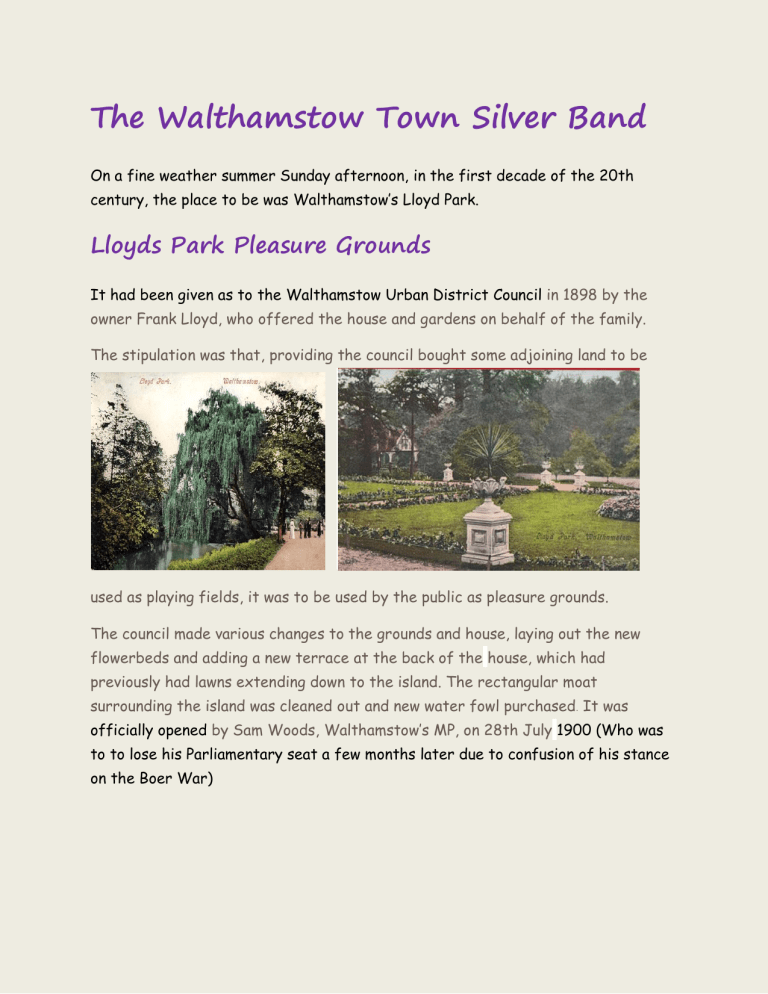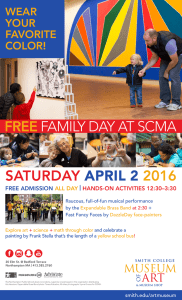The Walthamstow Town Silver Band

The Walthamstow Town Silver Band
On a fine weather summer Sunday afternoon, in the first decade of the 20th century, the place to be was Walthamstow’s Lloyd Park.
Lloyds Park Pleasure Grounds
It had been given as to the Walthamstow Urban District Council in 1898 by the owner Frank Lloyd, who offered the house and gardens on behalf of the family.
The stipulation was that, providing the council bought some adjoining land to be used as playing fields, it was to be used by the public as pleasure grounds.
The council made various changes to the grounds and house, laying out the new flowerbeds and adding a new terrace at the back of the house, which had previously had lawns extending down to the island. The rectangular moat surrounding the island was cleaned out and new water fowl purchased
.
It was officially opened by Sam Woods, Walthamstow’s MP, on 28th July 1900 (Who was to to lose his Parliamentary seat a few months later due to confusion of his stance on the Boer War)
Facilities & Amenities
From early on there was a bandstand on the island and in 1906 another bandstand was erected on the lower field. There was a children’s gymnasium with separate areas for boys and girls and a sports pavilion that was used by many local clubs
These including Walthamstow Avenue FC who between 1905-10 made this there home ground. Other early park amenities included a grotto, shelters, toilets, refreshments kiosk, rockery, fish pool, drinking fountains, an Attendants Office, a bowling green and tennis courts
.
For us today, it is difficult to realize just how crowded Walthamstow was in 1911.
The population had risen from 95,531 people in 1901 to 124,580 in 1911.
Most people worked six days a week and their only recreation time was on a Sunday. This was before the time when people owned cars and were mobile and most relied on a combination of tram, omnibus transport and ‘shank’s pony’.
A Fine Summer Sunday Afternoon
On a fine Summer Sunday afternoon, the pleasure grounds would have been crowded with people using the amenities. Families would picnic and their children would use the gymnasiums. Mothers would walk their perambulators around the pond, Young men and women in dressed in their Sunday ‘best would promenade around the paths hoping to catch each other’s eyes.
Oh! Listen To The Band
Many came to listen to the Silver bands that sat on the bandstands and played a combination of light classical and popular music. Local bands included:
Walthamstow Citadel Band (Later called the Salvation Army band)
Walthamstow Oddfellows
Band
Walthamstow Silver Band
Walthamstow Temperance
Band
Walthamstow Northern Ward
Silver Prize Band
Other than the various
Salvation Army bands, that generally played in the street, the most enduring local band was the Walthamstow Town
Band that, we know, was active in 1896, 1905, 1911 and 1923
Brass & Silver Bands
By the end of Queen Victoria's reign, brass bands were one of the principal focuses of community music making in the United Kingdom. There were, if we are to believe the optimistic forecasts, 40,000 of them. Such a statistic would indicate that the number of people playing in brass bands by the end of the century was something in the region of 800,000.
At about the same time, audience attendance at open air brass band contests was, according to the highest estimate, 160,000 at a single event. This figure was quoted following the 1900 National Brass Band Contest at the Crystal Palace. It should not, of course, be taken literally, but it is probably a good indicator of popular impression.
When Queen Victoria ascended to the throne in 1837, the term '"brass band" meant nothing more than an ensemble of miscellaneous wind instruments in which brass instruments were prominent. At the end of the century the term was more closely defined. Brass bands had become the raison d'etre for a widespread and intricate organizational structure that was largely controlled by working-class people.
Left: The Walthamstow Lighthouse Band c1900
While today we tend to use the generic term of brass bands, this wasn’t always the situation as many bands made a point of describing themselves as ‘silver’ bands.The difference between ‘silver’ and ‘brass’ bands is that ‘silver’ band instruments are silver plated and therefore more expensive than brass instruments. It was really a class difference as most of the ‘silver’ bands were in the more affluent south of
England and the ‘brass’ bands in the less wealth north of England.
In the north of England brass bands were very much linked to industry and many collieries and companies had their own bands. Successful bands were a good advert
for the industry that sponsored them and many were willing to provide the finance needed to equip and maintain a band.
Today, although not in the same numbers as previously, brass and sliver bands are very much alive and well and Walthamstow’s East London Brass Band maintains the tradition of playing in bandstands and has rehearsed in the Trinity United Reform
Church in Walthamstow for several years.
Below: The East London Brass Band playing at West Hampstead bandstand in 2013
Bill Bayliss
March 2015
Some sources used in this article: http://www.lipscomb.edu/windbandhistory/rhodeswindband_07_britishbrassband.htm
http://www.themouthpiece.com/vb/archive/index.php/t-47227.html
http://brassbandresults.co.uk/contests/walthamstow-contest/1896-08-29/ http://www.ibew.org.uk/vbbp-uk4.htm
http://www.historicbrass.org/portals/0/documents/journal/1992/hbsj_1992_jl01_001_herbert.pdf
http://londonliving.at/london-grilling-with-east-london-brass/



